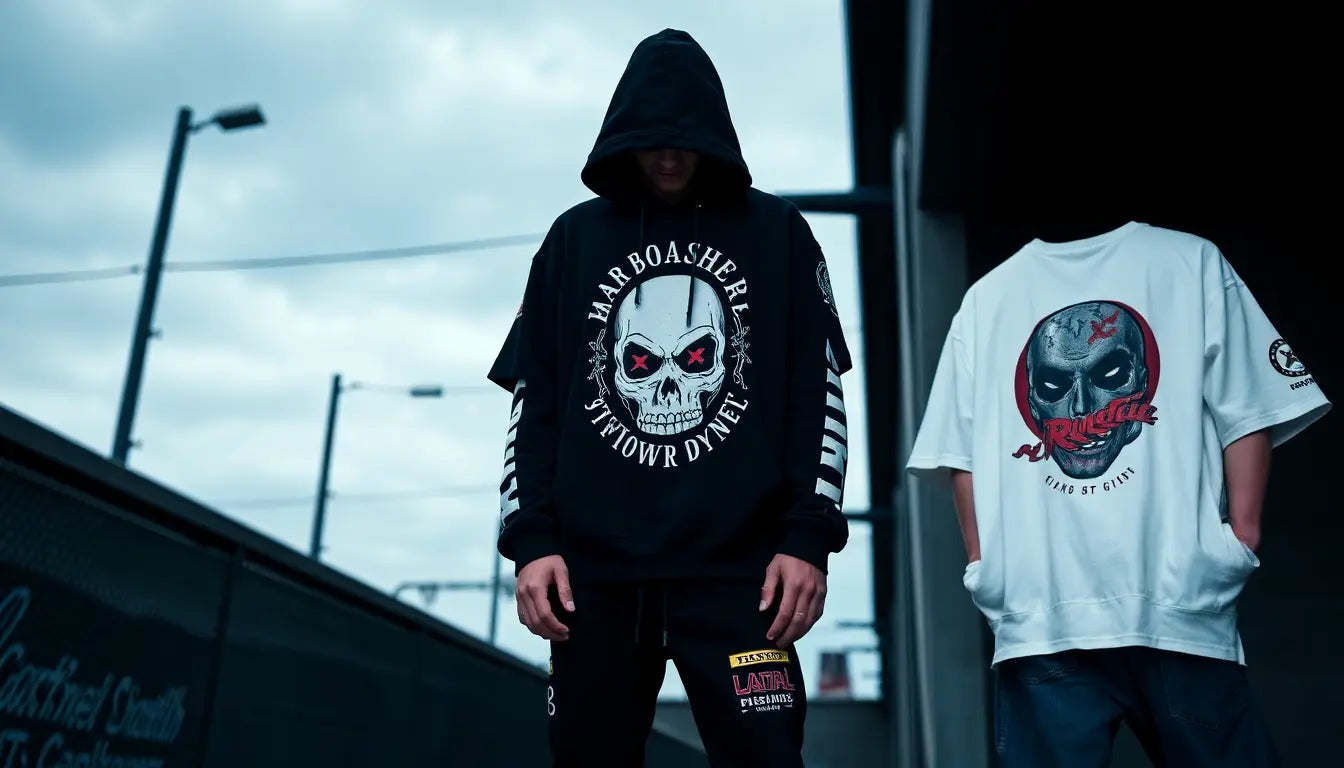
Tommy Lee Sparta Merch: How Island Aesthetics Became Global Dancehall Streetwear Hits
Introduction
Tommy Lee Sparta merch has transcended vendor stalls and concert tents to become a recognizable influence in global streetwear. Rooted in the rhythms and imagery of Jamaican dancehall, the apparel that carries his name blends island identity, subcultural edge, and smart fashion mechanics to create items that resonate far beyond the island. This long-form guide explains how those pieces made the jump, and provides practical insight for fans, retailers, designers, and marketers who want to understand or replicate that success.
Understanding the Artist and the Cultural Context
Tommy Lee Sparta emerged as a distinct voice inside dancehall music, notable for a darker, more gothic visual language than many of his peers. Dancehall itself is an ecosystem where music, dance moves, catchphrases, jargon, and fashion feed each other. Merchandise in this context is not just product; it is a vessel for identity, belonging, and storytelling. For many fans, wearing artist merch signals both musical taste and social affiliation.
From Local Naunce to Global Appeal: A Timeline Overview
- Early phase: grassroots selling at shows, local boutiques, and word-of-mouth trade created initial demand and embedded pieces within fans' lived experiences.
- Expansion phase: as the artist's visibility grew on digital platforms and at international shows, demand spread to diasporic communities and genre-curious audiences abroad.
- Refinement phase: merchandising moved from simple logo tees to curated drops, distinctive graphics, and collaborations with designers and retailers that matched global streetwear sensibilities.
Design Language: Island Aesthetics Meets Streetwear
What makes Tommy Lee Sparta merch visually distinctive is the marriage of island-rooted symbols with streetwear codes. Those design choices are intentional and translate across markets:
- Palette: preference for deep, muted palettes and high-contrast prints contrasts with stereotypical tropical colorways, creating a signature look that reads as edgy rather than novelty.
- Iconography: religious motifs, gothic symbols, and localized references appear alongside dancehall catchphrases and lyrical nods, creating layered meaning for informed fans.
- Silhouette and fit: oversized tees, heavy hoodies, and utility-forward pieces align with contemporary streetwear fits, making them compatible with broader wardrobes.
- Texture and finish: distressed fabrics, pigment washes, and vintage-style printing give an impression of history and authenticity.
Brand Storytelling and Narrative Control
Merchandise is storytelling in wearable form. Successful Tommy Lee Sparta drops pair visuals with clear narrative cues: what the design means, where it was inspired from, and how it connects to the wider cultural moment. That storytelling appears in product descriptions, drop announcements, lookbooks, and social posts that contextualize art and design for both hardcore fans and newcomers.
Production, Quality, and Perceived Value
One reason the merch reached beyond fans is the emphasis on material quality. Durable fabrics, reliable stitch work, and attention to print techniques make garments desirable beyond their branding. Quality impacts resale value and word-of-mouth recommendations — both essential for organic growth.
Distribution Models That Scaled Reach
- Direct-to-consumer (DTC): selling through official online stores and at live events maximizes margins and strengthens brand control.
- Pop-ups and festival stalls: short-term physical presences at high-footfall events generate buzz and allow fans to experience the products in person.
- Selective wholesale: partnering with reputable boutiques and streetwear retailers in key cities introduces the merch to new audiences without diluting brand positioning.
- Third-party marketplaces: these help reach global buyers but require strict brand governance to prevent counterfeits and inconsistent pricing.
Drop Strategy and Scarcity Mechanics
Scarcity is a powerful driver in contemporary streetwear culture. Limited editions, numbered runs, and timed drops create urgency. For Tommy Lee Sparta merch, scarcity was effective because it was paired with meaningful design and community storytelling, not manufactured hype alone. Smart drop strategies include staggered releases, waitlists for engaged fans, and exclusive event-only items.
Marketing Channels and Community Engagement
Marketing combined traditional music promotion with lifestyle imagery: social media, music videos, live performances, and influencer placements worked together to normalize the apparel as both fandom and fashion. Community-first tactics were especially effective:
- Fan-driven content: reshares of fan photos built social proof and served as free style guides.
- Engagement through comments and live streams: answering questions about sizing, story, and restocks helped maintain trust.
- Street-level ambassadors: local DJs and dancers who wore pieces in everyday environments introduced the merch to subcultural scenes.
Styling Guide: How Audiences Wear the Merch
The pieces work across multiple looks because they balance signature details with adaptable silhouettes. Here are practical outfit ideas:
- Day-to-day streetwear: oversized tee, tapered cargo joggers, retro sneakers, and a crossbody bag for function.
- Layered winter vibe: hooded sweatshirt under a utility jacket, work boots, and a knit beanie to anchor the darker palette.
- Festival or performance-ready: lightweight hoodie or muscle tee, breathable pants, fanny pack, and sturdy sneakers for movement.
- High-low styling: combine a merch piece with elevated items like tailored outerwear or designer accessories for a fashion-forward twist.
How to Verify Authentic Merchandise and Avoid Fakes
As a brand grows, counterfeit risks increase. Safeguards include:
- Buy from verified channels: official store, artist's verified social links, or reputable retailers.
- Inspect construction: authentic pieces usually use heavier materials, better stitching, and higher-quality prints.
- Check labeling and packaging: official merch often includes artist branding, tags with production details, and consistent packaging elements.
- Price signals: if a product is priced far below typical retail, it may be counterfeit.
Pricing, Collector Culture, and Resale
Pricing strategy matters for both accessibility and perceived value. Lower-priced staples help maintain a strong fanbase, while limited-edition pieces can command higher margins and fuel collector interest. When resale markets develop, they further validate desirability but can also complicate access for true fans — balancing initial allotments for fan clubs or presales can help maintain goodwill.
Legal and IP Considerations
Artists and their teams must manage trademarks, licensing contracts, and copyright for graphic elements. Protecting logos, key phrases, and signature artwork deters knockoffs and preserves licensing opportunities. When working with outside manufacturers or collaborators, clear contracts that define rights, royalties, and usage limits are essential.
Sustainability and Ethical Production
Streetwear consumers increasingly value sustainable practices. Options to consider:
- Use organic or recycled fabrics and disclose material sources.
- Work with suppliers that provide transparent labor practices and certifications.
- Offer repair services or limited restocks to reduce overproduction.
Digital Commerce: SEO, Product Pages, and Conversion Tactics
To rank well and convert shoppers, follow modern e-commerce and SEO best practices. Practical recommendations include:
- Product page essentials: clear H1 tags, descriptive meta descriptions, fast-loading product images with optimized alt text, and structured data (schema) for product, price, and availability.
- Keyword strategy: integrate primary keywords like tommy lee sparta merch, tommy lee sparta hoodie, dancehall streetwear, and supplemental long-tail phrases such as authentic tommy lee sparta tee and island aesthetic streetwear.
- Content marketing: publish long-form blog posts, lookbooks, and behind-the-scenes features that target high-intent queries and cultural searches about dancehall fashion.
- Site performance: prioritize mobile-first design and fast page speeds — many fans discover merch on social platforms via mobile devices.
- User reviews and UGC: show real customer photos and reviews to improve trust signals for both users and search engines.
Technical SEO Examples to Implement
- Meta description example: Shop authentic Tommy Lee Sparta merch — hoodies, tees, and limited drops inspired by dancehall culture. Free shipping over 75 and secure checkout.
- Suggested URL slug: /product-category/tommy-lee-sparta-merch
- Image alt text examples: 'tommy lee sparta black hoodie front print', 'limited edition tommy lee sparta tee back graphic', 'fan wearing tommy lee sparta merch at concert'.
- Schema: use Product schema with price, currency, availability, SKU, and aggregateRating fields when available.
Metrics to Track for Ongoing Growth
Measure success with both marketing and product KPIs:
- Conversion rate on product pages and drops
- Average order value (AOV) and CLTV for repeat buyers
- Time-to-sell for limited editions and rate of sell-through
- Social engagement metrics tied to drop announcements
- Return rates and customer satisfaction scores
Community and Cultural Responsibility
Because merchandise carries cultural meaning, creators must be mindful of authenticity and respect. That means:
- Engaging with local communities and creatives for design input
- Providing context for symbols and lyrics that appear on garments
- Giving back: allocating a portion of proceeds to community initiatives or cultural preservation where appropriate
Case Studies and Lessons Without the Hype
While some artist merch grows purely through celebrity endorsement, more sustainable growth comes from aligning product to culture, ensuring quality, and managing scarcity responsibly. The pattern of success often includes:
- Strong original visuals that fans identify with immediately
- High-quality construction that justifies price and encourages repeat buyers
- Consistent storytelling in both music and product marketing
- Strategic channel mix that balances DTC control with select retail partnerships
Frequently Asked Questions (FAQs)
-
Where can I buy authentic Tommy Lee Sparta merch?
Official channels like the artist's verified online store and in-person vendor tables at shows are the safest sources. Verified retail partners and pop-ups announced on official social accounts are also reliable.
-
How do I know if a piece is limited edition?
Limited editions are usually promoted as numbered runs, released with specific drop dates, or sold exclusively at particular events. Product descriptions and official announcements will state edition sizes when applicable.
-
Are these pieces suitable for everyday wear?
Yes. The silhouettes and materials are designed to work within everyday streetwear, though some limited pieces may be collector-oriented and handled with extra care.
-
How should I care for my merch to maintain value?
Follow label instructions: wash inside out on cold cycles, avoid high-heat drying for printed items, and consider gentle handling for vintage-effect pieces.
Conclusion
The journey of Tommy Lee Sparta merch from island-rooted expressions to global streetwear signals offers a playbook for musicians and brands. It is a reminder that authenticity, quality, cultural context, and smart commerce mechanics together create durable desirability. Whether you are a fan looking to buy, a retailer considering a partnership, or a creator planning a drop, the underlying lesson is clear: design with story, produce with care, and communicate with the community.
Call to Action
Ready to explore authentic pieces or plan a merch strategy inspired by dancehall aesthetics? Follow official artist channels for drop announcements, sign up for newsletters on verified stores, and if you are a creator, start with community collaboration and strong product quality to build long-term value.


